Underwater Image Restoration and Enhancement via Residual Two-Fold Attention Networks
 , Liyan Wang1, Ruizi Wang1, Shilin Fu1, Fangfei Liu1, Xin Liu2
, Liyan Wang1, Ruizi Wang1, Shilin Fu1, Fangfei Liu1, Xin Liu2- DOI
- 10.2991/ijcis.d.201102.001How to use a DOI?
- Keywords
- Deep residual network; Underwater image restoration; Nonlocal attention; Channel attention; Image de-noising; Image color enhancement
- Abstract
Underwater images or videos are common but essential information carrier for observation, fishery industry and intelligent analysis system in underwater vehicles. But underwater images are usually suffering from more complex imaging interfering impacts. This paper describes a novel residual two-fold attention networks for underwater image restoration and enhancement to eliminate the interference of color deviation and noise at the same time. In our network framework, nonlocal attention and channel attention mechanisms are respectively embedded to mine and enhance more features. Quantitative and qualitative experiment data demonstrates that our proposed approach generates more visually appealing images, and also provides higher objective evaluation index score.
- Copyright
- © 2021 The Authors. Published by Atlantis Press B.V.
- Open Access
- This is an open access article distributed under the CC BY-NC 4.0 license (http://creativecommons.org/licenses/by-nc/4.0/).
1. INTRODUCTION
In recent years, protecting and exploring marine resources and developing marine related technologies have gradually become an important strategy of major marine countries in the world. Underwater images or videos are common but essential information carrier for observation, fishery industry and intelligent analysis in underwater vehicles. In the practical operation, some tasks such as underwater exploration, underwater terrain browsing, fish density analysis, sea-hood health status analysis and even automatic recognition and detection rely on high-quality underwater images to ensure the smooth progress of visual analysis tasks. However, compared with the natural images, the real raw underwater images and videos usually suffer from more complex imaging interfering impacts, e.g., light scattering and absorbing by suspended particles, light darkening in deep water environment, camera blurring, and so on. No matter act alone or jointly, these interference factors result in underwater images significant visual degradation effects such as low contrast and brightness, color deviation, details blur and many kinds of noise. Figure 1 shows the visual contract effects between the degenerate underwater images affected by noise and color deviation. It can be seen that the noise and color deviation by the degradation of underwater images are the important factors affecting the quality of underwater images. Underwater image restoration can improve the visibility by eliminating the adverse effects and restoring destroyed content in the imaging process [1].
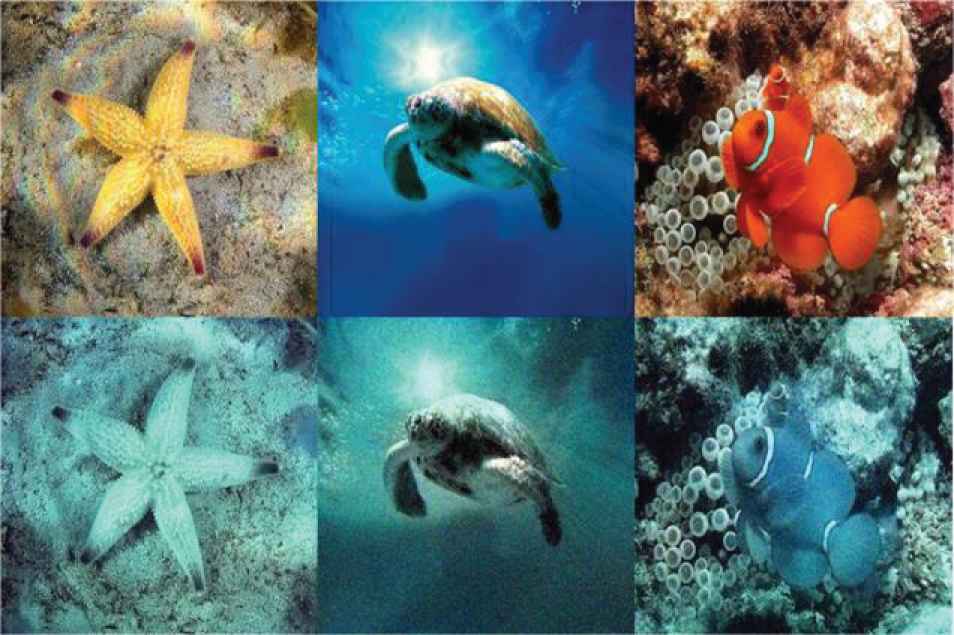
Three images in the top row are ground truth images, three images in the below row are degraded images.
In past few decades, underwater image enhancement and restoration methods range from two categories, i.e., physical priori model-based methods and data-driven techniques. Physical priori model-based methods tend to construct a model that can describe the degradation process of underwater images. And then, they usually adopt any optimizer to estimate parameters of model. For example, Trucco and Olmos-Antillon [2] designed a simplified Jaffe- MeGlamery underwater imaging model, the parameters used in the filter can be estimated by a contrast quality decision function. Fan et al. [3] proposed point spread function (PSF) and used it in underwater image restoration. Many scholars have applied the dark channel model which proposed by He et al. [4] to underwater image restoration. Some statistics properties-based methods do not build the physical represent model, but construct subjective statistics criteria in some aspects (e.g., histogram), so as to achieve satisfactory visual effect. Ramesh [5] used histogram equalization, noise de-noising filter and repeated interpolation method to improve underwater images quality and enhance detail information. Although the physical priori model-based methods improve the quality of underwater images, these methods usually are self-learning rather data-learning. Less learning data often leads to inaccurate estimation of model's parameters, and disable to obtain satisfactory restoration effect.
With rapid development of deep learning technology, more and more deep learning tools, e.g., convolutional neural network (CNN), recurrent neural network (RNN) and generative adversative network (GAN) are respectively applied in the computer vision field and achieved significantly improved performances [6–9].
As a kind of typical methods of data-driven techniques, underwater image enhancement methods based on deep learning can fully learning parameters of model or target function through huge amount of data. Some researchers have attempted to utilize the deep learning techniques to the underwater image enhancement. For example, Li et al. [10] used GAN to estimate clear image through a large number of training image data sets and some underwater depth data as an end-to-end input, so as to restore image features and enhance visual effect. Zhu et al. [11] introduced a notion of image translation to generate two training sets, and peer sub-networks can learn self-style and transfer by adversarial loss each other. It got obvious visual color restoration effect but still owned some deficiencies in geometry restoration effect. Islam et al. [12] introduced many factors, i.e., image content, color and texture details to design target function of network. However, abovementioned methods usually only consider one degradation factor, we are unable to observe a deep learning method for underwater image enhancement which take into account many kinds of underwater degradation factors. Meanwhile, the phenomenon of gradient disappearing and exploding often appears in networks for underwater image enhancement, which limits the training performance.
In this paper, focus on underwater image degradation problem with multiple factors, i.e., color deviation and noise, we propose a novel residual two-fold attention network named RTFAN. In RTFAN, nonlocal attention and channel attention (CA) mechanisms are introduced into a whole residual network framework to suppress noise and enhance details respectively. Quantitative and qualitative experiment data demonstrates that our proposed approach generates more visually appealing image, and also provides higher objective evaluation index score.
2. RELATED WORK
Nowadays, a number of successful deep learning approaches toward different underwater image degradation have been proposed, e.g., de-noising, color restoring and de-blurring problems, etc. [13]. Different architectures of deep neural networks often show different characteristics of data processing. From an architecture perspective, the methods mentioned above can be basically divided into (1) encoder to decoder, (2) generative adversative, (3) multi-branch and (4) modular architectures.
In general, methods based on encoder to decoder architecture are adopted in restoring details of images, so as to often be applied in de-noising and de-blurring tasks. For example, Sun et al. [14] used pixel to pixel (P2P) network which an encoder to decoder model to enhance underwater images. Compare to encoder to decoder model, GAN model owns an additional adversative discriminator, so it can consider more constraint for image color style. Li et al. [10] used GAN to restore image features and enhance visual effect. Uplavikar et al. [15] used domain adversarial learning to learn agnostic model where it can enhance multi-types underwater images. Fabbri et al. [16] used gradient penalty as the soft constraint on the underwater output which named underwater generative adversarial network (UGAN).
Although these two categories of methods have achieved good results, they are not good at dealing with underwater degraded images with multiple degradation factors. There are two reasons leading to the shortcomings of the above algorithms. Firstly, underwater image features extracting becomes more difficulty with multiple degradation factors interfering. It leads to that the feature extracted by the convolution layer is not accurate enough, which is not conducive to the recovery of features. Secondly, due to the inaccuracy of feature extraction, it is often necessary to increase the network depth. But simply increasing the depth will produce gradient disappearance or explosion. Multi-branch architecture is usually adopted to overcome the above problems. For example, Wang et al. [17] presented a deep CNN method for enhancement of underwater images, namely, UIE-Net, which is composed of three sub-networks, and each branch can focus on extracting some specific features. Another modular architecture such as residual network and dense net can also increase the number of network layers by skip connection. Due residual architectures can partly prevent the phenomenon of gradient disappearing, thus increasing the number of layers of the network and improving the effect of feature extraction. Guo et al. [18] introduced a multi-scale dense block, named DenseGAN which employs the use of dense connections, residual learning and multi-scales network for underwater image enhancement.
Attention mechanism is another effective way to enhance network features. The core ideal of attention mechanism is enhancing some particular encoder features. At present, there are two types of attention mechanisms, i.e., CA and spatial attention (SA). The CA attention acts on the channel scale, weighting different channel features and SA attention is weighted on the spatial scale, weighting different spatial regions. Zhang et al. [19] introduced CA attention to improve the performance of the network and propose a residual CA networks named RCAN. Some scholars try to introduce manifold constraints into deep networks to mine local features correlation and suppress noise. Liu et al. [9] proposed a recurrent network for image reconstruction. Zhang et al. [20] proposed a residual nonlocal attention network for high-quality image restoration. It also has good performance in image de-noising, mosaic removal, compression, artifact reduction and super-resolution.
Inspired by the advantages of the attention mechanism, such as the enhancement of specific network features, and deeper network architecture by skip connection. We propose a novel two-fold attention residual network for underwater image enhancement and restoration with noise and color degradation factors simultaneously interfere. In our solution, residual architecture is adopted to ensure network deep enough, and a nonlocal attention is conducted in shallow layer to suppress noise and extract color features, and CAis conducted in subsequent layers to enhance detail features.
3. METHODOLOGY
The real raw underwater images usually suffer from complex imaging interfering impacts, e.g., light scattering and absorbing by suspended particles, light darkening, which leads to color deviation, noise effects of underwater images. In this paper, focus on underwater images degradation problem with multiple factors, i.e., color deviation and noise, we propose a novel residual two-fold attention network named RTFAN.
3.1. Underwater Image Modelling
According to Jaffe-MeGlamery underwater imaging model, underwater imaging is mainly composed of three parts, i.e., direct component, forward scattering component and back scattering component. Figure 2 shows the basic composition of the underwater model [21]. Where, x denotes the target position and D denotes the depth of the water. D(x) represents the distance from the target to the sea level and d(x) represents the distance between the target and the acquisition equipment.
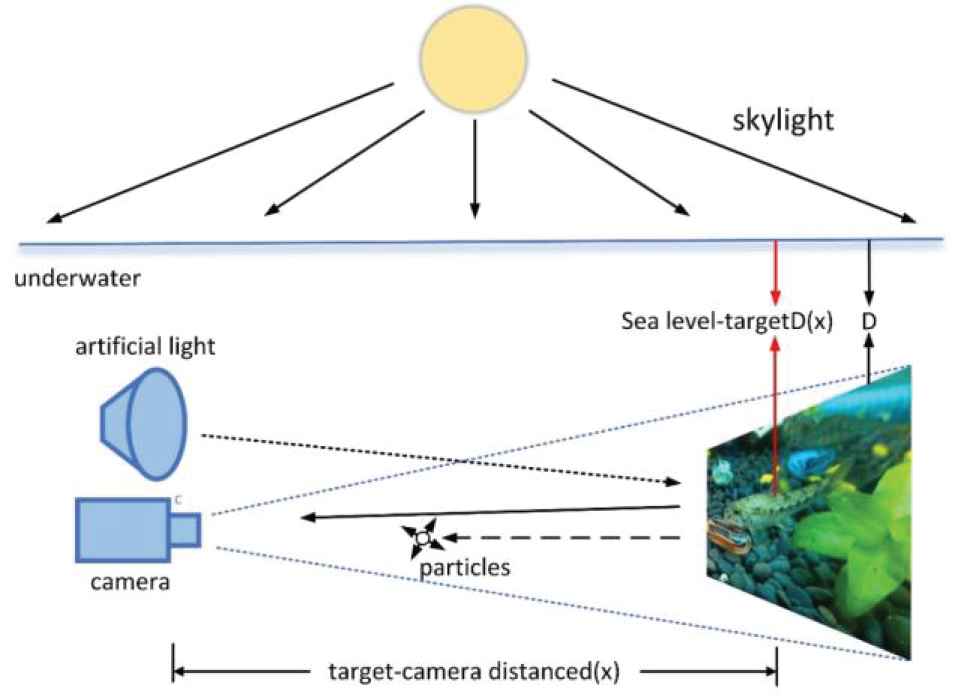
Figure of underwater imaging model.
The underwater image model can be formally expressed as follows:
Here, x denotes the x-th pixel in image, I(x) denotes degraded underwater image, J(x) denotes the source clear image, t(x) denotes transmittance of scene light,
The degraded image F(x) taking into account noise and color deviation can be expressed as follows:
So, we can express source image J(x) as follows:
3.2. Objective Function Minimization
Given a source domain X (degraded image F(x)) and an expected domain E, we adopt any neural network can get the mapping function as follows:
Here, E denotes the expected image, J(x) denotes the source clear image. The goal of our algorithm is to find a mapping that minimizes the function by training the network.
3.3. Architecture of Residual Two-Fold Attention Networks (RTFAN)
Figure 3 shows a basic architecture of our RTFAN, includes three parts, i.e., shallow feature de-noising module, deep feature enhancement module and reconstruction module. In shallow feature de-noising module, there are one convolution layer and one nonlocal de-noising module named Conv_nl, respectively. The nonlocal de-noising module can suppress noise and extract feature. The deep feature enhancement module is to further mine the image details, and it consists of four residual CA blocks (RCAB), one convolution layer and one long skip connection, detailed RCAB structure is shown in Figure 4 [19]. In RCAB, there are two Conv layers, a Relu activation layer and a CA module, which is introduced in section 3.4.2. Following the structure of RCAB, there is a deconvolutional layer to reconstruct the image.

Architecture of residual two-fold attention networks (RTFANs).
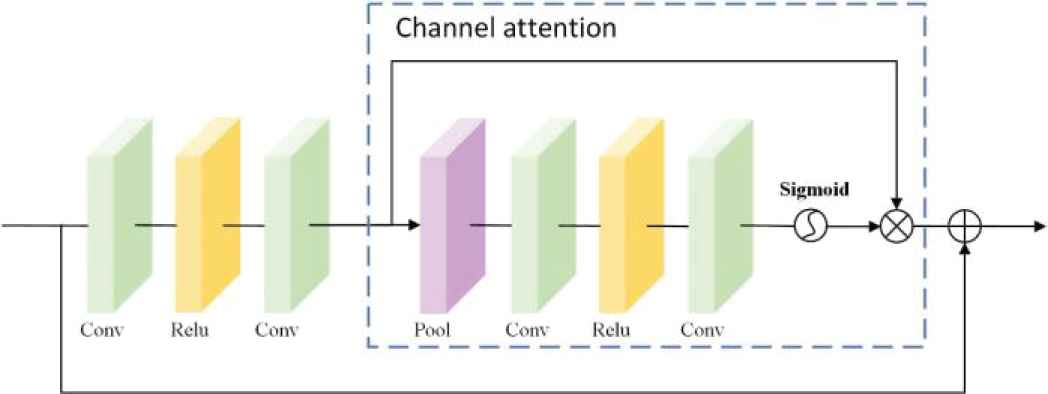
Residual channel attention block (RCAB).
Based on the RTFAN, we further formalize the objective function of formula into the following minimum loss function.
Here,
3.4. Two-Fold Attention Mechanism
In RTFAN framework, nonlocal attention and CA are embedding to extract and enhance features. Nonlocal attention modular is set in shallow layers, and it focus on suppressing noise and extracting color style features. CA modular is set in deeper layers, and it focus on enhancing detail features.
3.4.1. Nonlocal attention modular
Motivated by literature [20,22], nonlocal attention operator is modularized into a modular block, it is shown in Figure 5. In nonlocal attention block, input data size of B × 3 × H × W passes a convolution layer with 64 filters to obtain a set of shallow features size of B × 64 × H × W. And then compute nonlocal correlation and enhance features. In this step, we adopt 1 × 1 convolutional operators and softmax function to learn three weight matrix
Here,
Here,
3.4.2. CA modular
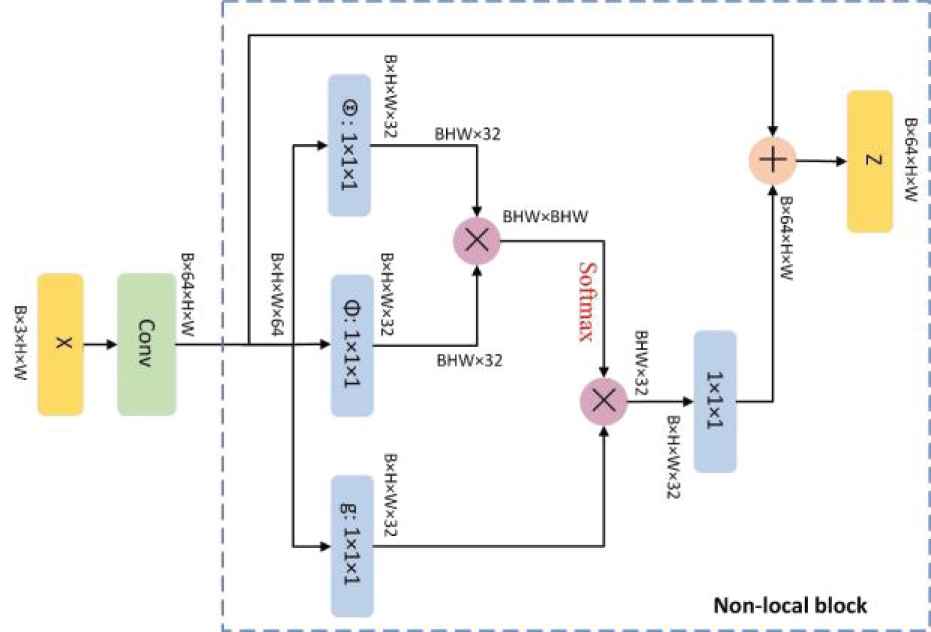
Nonlocal attention.
The core idea of CA is cooperative work of channels and gating mechanism (sigmoid). Figure 6 shows basic structure of CA. Firstly, the spatial information is transformed into channel feature with 1 × 1 × C size by a global average pooling. Secondly, convolutional operation is carried out with the weight of WD, which is activated by Relu activation function, and the channel feature with 1 × 1 × C/r size is down-sampled with the ratio r. Then, another convolution operation is carried out with the weight of WU to upscale with the ratio r, 1 × 1 × C channel feature is obtained. Finally, after being activated by sigmoid function (denoted as f), the final channel feature with 1 × 1 × C is obtained, and is further multiplied with input to obtain output.
It can be seen from Figure 6, CA mechanism can better enhance deeper features. In view of this characteristic of CA mechanism, our RTFAN apply CA modular in deep layers and the deep feature enhancement module named as
Here, Z and W denote the input and output of the deep feature enhancement module, respectively.
In the last layer of RTFAN, we apply a deconvolution to reconstruct features, marked as
4. EXPERIMENTS
4.1. Experimental Setting
Dataset We use 5550 paired underwater images from EUVP [12] as the data set, where 5022 pairs are used for training and the rest are verified and tested. For the noisy image training set, the simulated Gaussian noise is added to the original data set.

Channel attention.
Baseline algorithm We use four existing underwater image enhancement algorithms as baselines, including cycleGan [11], funieGAN [12], RCAN [19]. We also compare with our previous work, named Color-diff Net [22]. For fair comparison, all methods' code implementations are their publicly available versions and their parameters are set following the guidelines in original articles. In addition, our algorithm and all comparison algorithms adopt the above consistent data set.
Evaluation Metric The peak signal-to-noise ratio (PSNR) and the structural similarity (SSIM) index are adopted to measure the objective performance of our algorithm.
4.2. Network Architecture and Training Details
We choose the network architecture of Zhang et al. [19] as our basic network framework. Our network consists of a shallow feature de-noising module, a deep feature enhancement module and a reconstruction module. Among them, the shallow feature de-noising module is composed of a convolutional layer and a nonlocal module, while the deep feature module mainly contains four residual channel attention blocks (RCABs) and skip links. In each RCAB, there are two convolutional layers with size of 3 × 3 filters and a CA block module. In the CA block module, input data is squeezed into size of 1 × 1 × C data by average pooling, then this 1 × 1 × C descriptors are put through the convolutional layers and activated by sigmoid function. During training step, the training images are cut into the patches with size of 48 × 48. The batch size is set as 16, the learning rate is set as le-4 and the ADAM is adopted as optimizer of our model.
In our method, we only train 300 epoch for our model. We choose same training dataset, iteration times and network parameter for comparison methods. Our network framework is based on the PyTorch platform, and all experiments are implemented on a workstation with NVIDIA Titan X GPU and Core (TM) i7-7700K CPU.
4.3. Evaluation
4.3.1. Qualitative evaluations
Firstly, we qualitatively analyze the visual quality of degraded images with color deviation and noise factors restored by RCAN and RTFAN, respectively. As shown in Figure 7, most of the color information can be recovered from the RCAN-generated result when only the color deviation is considered. As the gaussian noise with noise intensity of 10 is added, simple RCAN cannot achieve a good effect of restoring color and removing noise at the same time. The RCAN network with only CA can correct the color properly, but it's de-noising ability is not strong. While, RTFAN network with only nonlocal attention can achieve simple de-noising tasks, but it cannot recover the real color information and detailed features. However, our RTFAN model can remove noise, perform color correction and get closer to the real image in visual effect. Therefore, we further prove the advantages in our model.
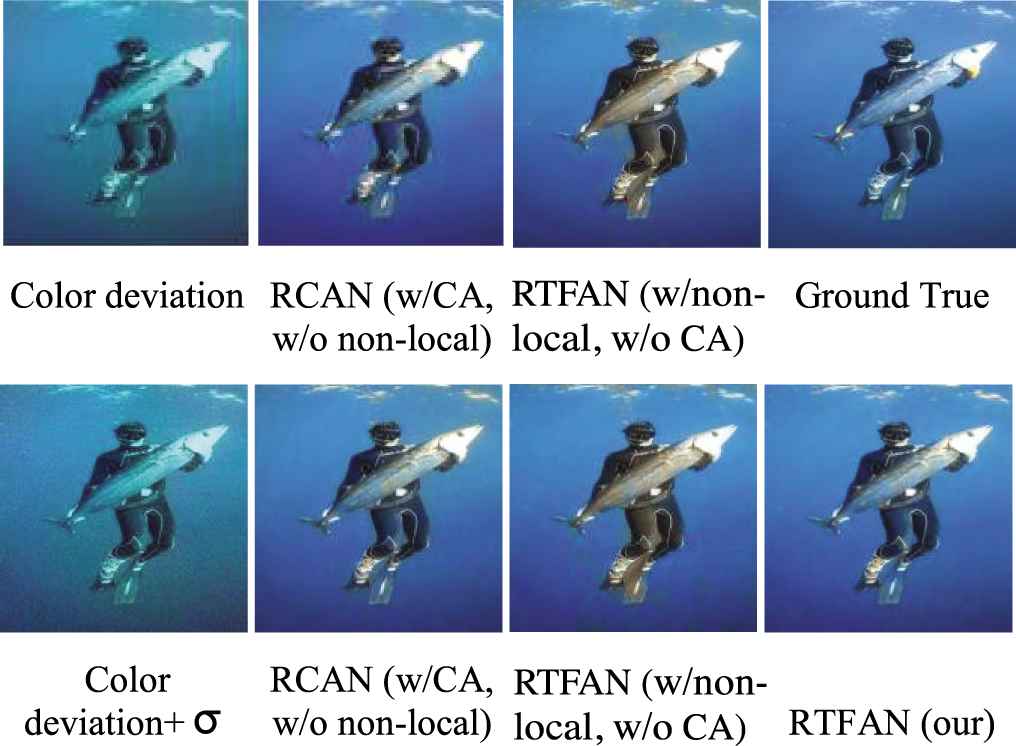
Visual contrast between RCAN model and our residual two-fold attention network (RTFAN) model with multiple factors.
Next, we use four underwater image enhancement models based on deep learning to make a qualitative comparison with our RTFAN model: (1) cycleGan [11], (2) funieGAN [12], (3)Color-diff Net [22] (our previously completed work), (4) RCAN [19]. We use the same noise data set for training on these models, and the test results are amplified, as shown in Figures 8–10.
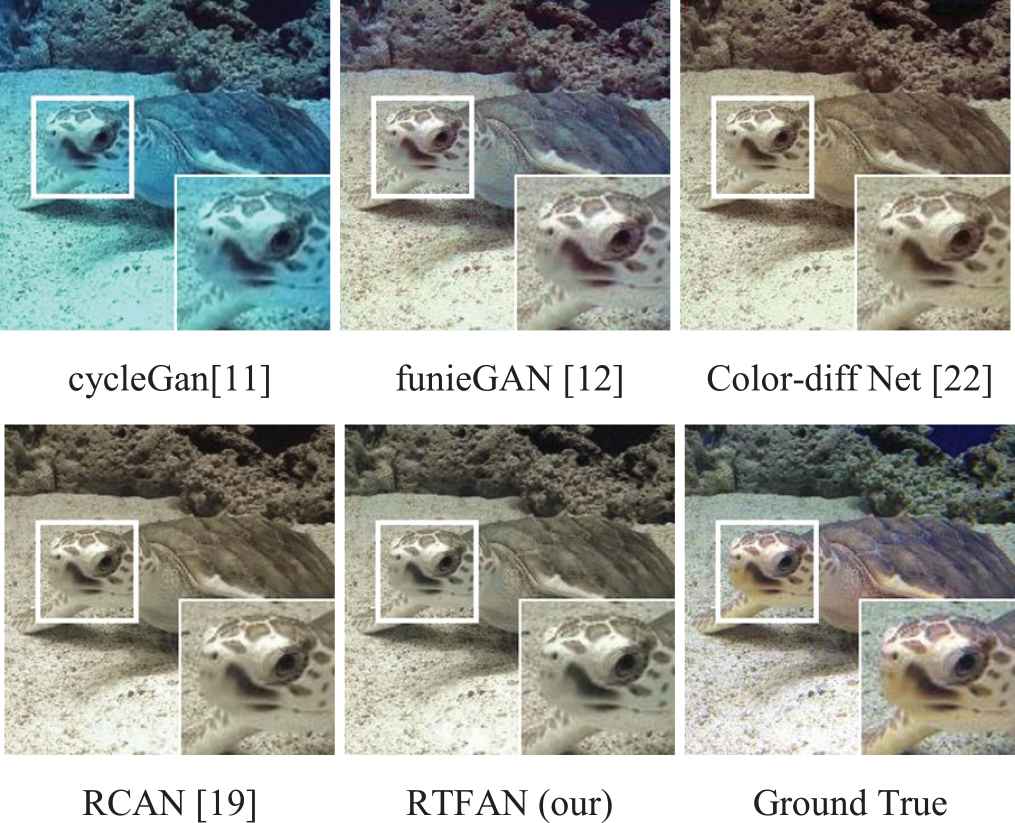
Comparison of enlarged view with noise intensity of 5.
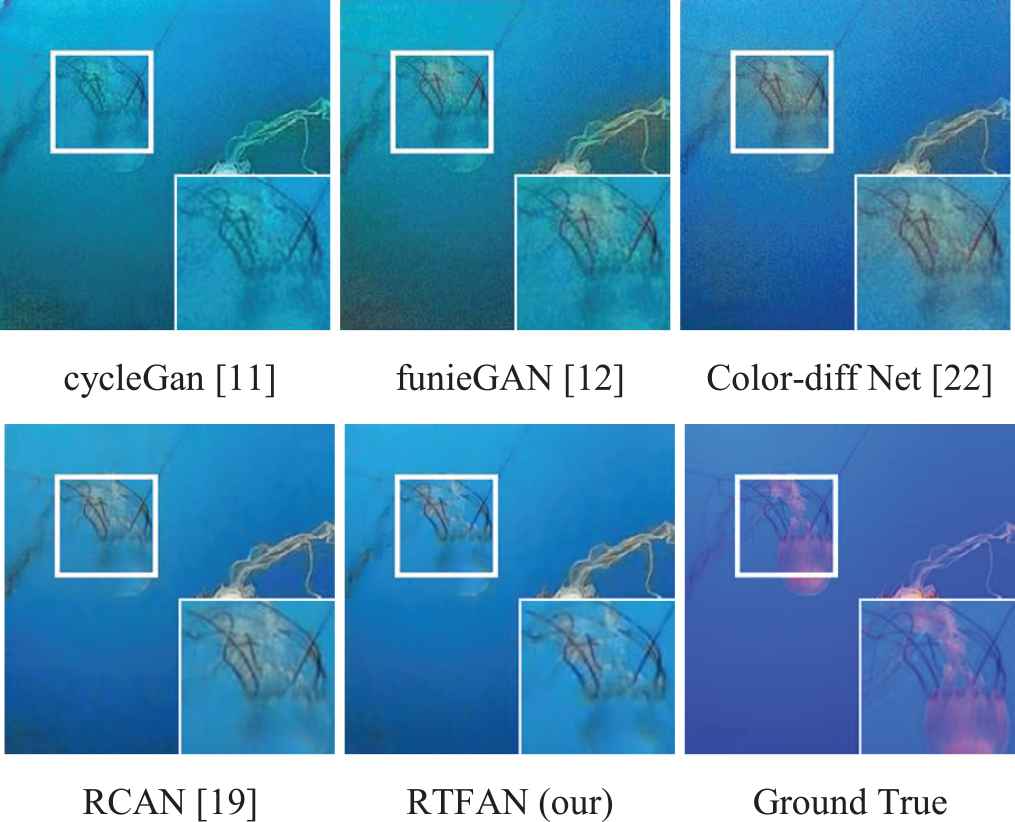
Comparison of enlarged view with noise intensity of 10.
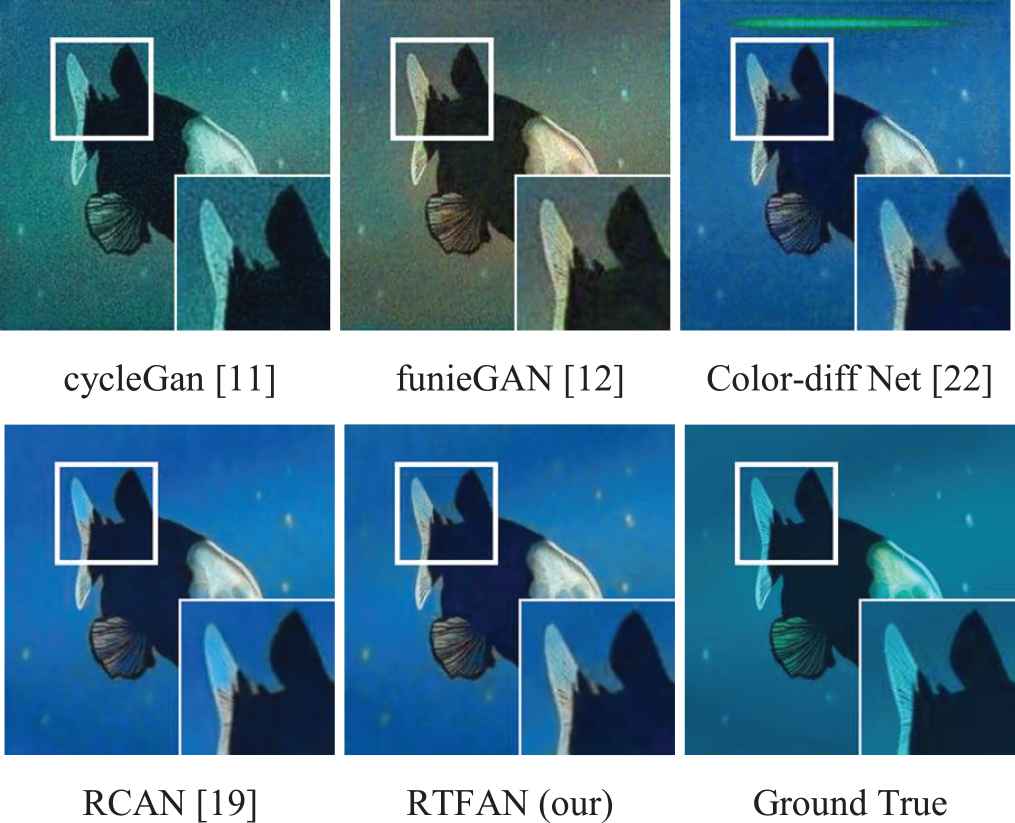
Comparison of enlarged view with noise intensity of 15.
Figures 8–10 shows the contrast of enhancement algorithms for underwater images with 5, 10 and 15 intensity of Gaussian noise, respectively. It can be seen that the cycleGan model and the funieGAN model cannot correct the color bias in the image, while Color-diff Net can correct the color, but the de-noising effect is not well. Relative to results above the performance of RCAN is better, but slightly inferior to our method. As a result, our approach is generally effective, which can not only remove noise and perform color correction, but also get closer to the real image in visual effect.
4.3.2. Quantitative evaluation
After qualitative evaluation, we use PSNR and SSIM to quantitatively compare the evaluation values of our method and other methods. As an objective standard for image evaluation, the PSNR mainly calculates the mean square error (MSE) between the real image and the processed image. The formula (11) is expressed as follows:
The SSIM is an index to measure the similarity of two images, which mainly considers the brightness, contrast and structure. The formula (12) is as follows:
| Algorithm | Evaluation Index | EUVP + Noise |
||
|---|---|---|---|---|
| 5 | 10 | 15 | ||
| cycleGan | PSNR | 16.35 | 16.27 | 16.26 |
| SSIM | 0.7773 | 0.7295 | 0.6858 | |
| funieGAN | PSNR | 20.52 | 20.10 | 20.21 |
| SSIM | 0.8797 | 0.8560 | 0.8381 | |
| Color-diff Net | PSNR | 22.06 | 21.80 | 21.48 |
| SSIM | 0.9017 | 0.8842 | 0.8574 | |
| RCAN | PSNR | 22.36 | 22.15 | 21.96 |
| SSIM | 0.8936 | 0.8729 | 0.8485 | |
| RTFAN | PSNR | 22.36 | 22.19 | 21.97 |
| SSIM | 0.8936 | 0.8708 | 0.8498 | |
The PSNR and SSIM scores of our method and some underwater image enhancement methods (best results are highlighted, our results are underlined).
It can be seen that in Table 1, our algorithm has obtained obvious advantages compared with other algorithms on PSNR, but the SSIM is a little deficient, the reason is that our RTFAN both considering de-noising and color deviation, so de-noising operation inevitably smooths the target image, which results in changing tiny detail construct. However, due to the underwater image is often polluted by noise, it is necessary to consider de-noising item. Figure 11 shows our algorithms more superior with increasing intensity of 10
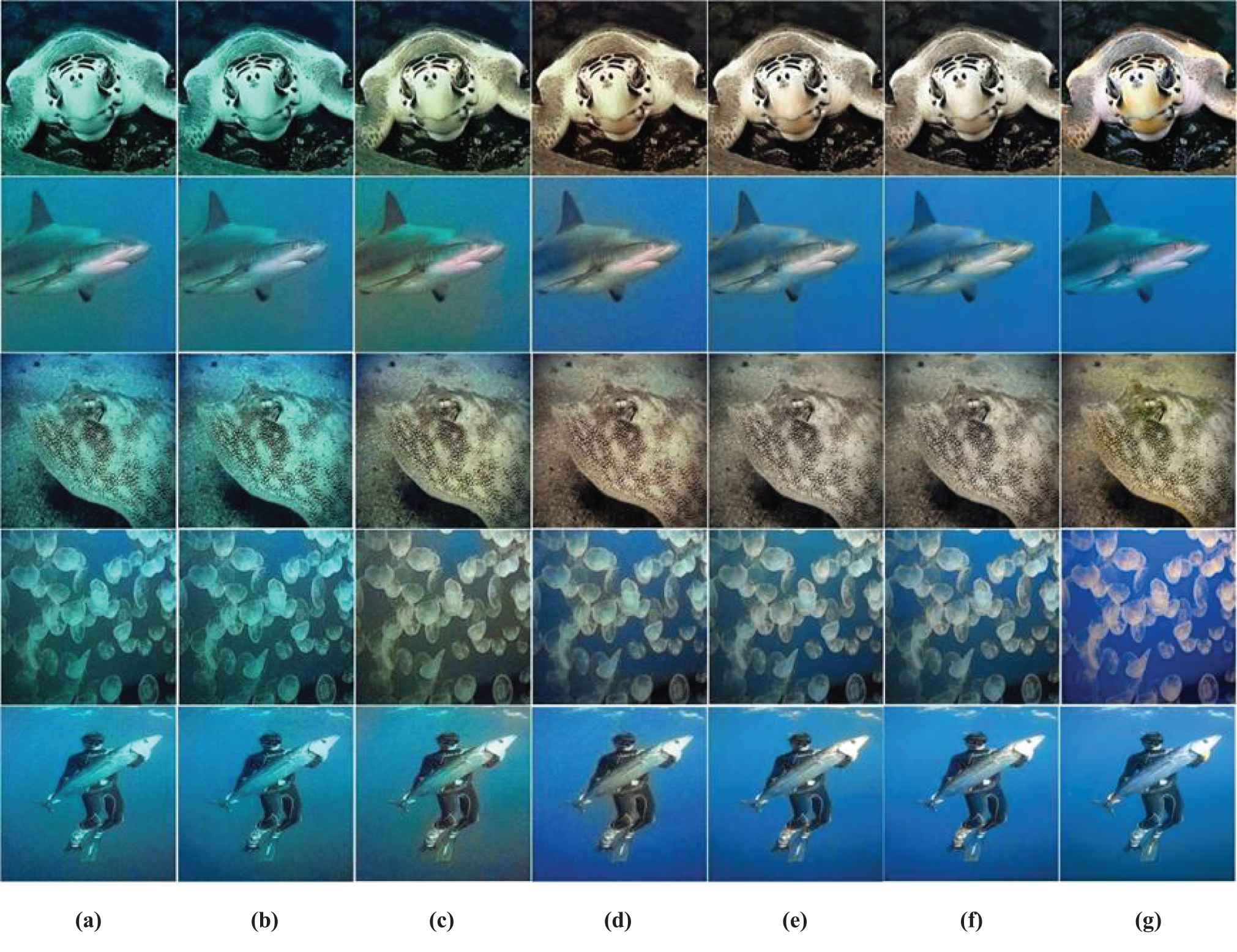
The enhanced result images: (a) input, (b) cycleGan, (c) funieGAN, (d) Color-diff Net, (e) RCAN, (f) residual two-fold attention network (RTFAN) and (g) ground truth.
4.4. Ablation Experiments
In order to further prove the effectiveness of our proposed algorithm and highlight the superiority of the two-fold attention mechanism, we conduct three different tests respectively. For example, (1) in the case of without noise, RCAN network with only CA mechanism; (2) RCAN network with only CA mechanism after adding 10 Gaussian noises; (3) in the case of without noise, RTFAN network with only nonlocal mechanism; (4) RTFAN network with only nonlocal mechanism after adding 10 Gaussian noises; (5) RTFAN network with the two-fold attention mechanism after adding 10 Gaussian noises. The visual effect is shown in Figure 7. The actual results were quantified by PSNR and SSIM, as shown in Table 2.
Whether from the visual effect or quantitative results, it can be concluded that our algorithm has certain advantages in the restoration of noisy underwater images compared with other algorithms.
| Dataset | Noise |
Methods | PSNR | SSIM |
|---|---|---|---|---|
| EUVP | 0 | RCAN(w/CA) | 22.430 | 0.90224 |
| EUVP | 0 | RTFAN(w/oCA) | 22.139 | 0.89840 |
| EUVP | 10 | RCAN(w/CA) | 22.151 | 0.87290 |
| EUVP | 10 | RTFAN(w/oCA) | 21.798 | 0.86094 |
| EUVP | 10 | RTFAN | 22.188 | 0.87075 |
Compared within and without noise (best results are highlighted, our results are underlined).
5. CONCLUSION
In this paper, we show a novel residual two-fold attention network for underwater image restoration and enhancement to eliminate the interference of color deviation and noise at the same time. In our network framework, nonlocal attention and CA mechanisms are respectively embedded to mine and enhance features. Quantitative and qualitative experiment data demonstrates that our proposed approach generates more visually appealing images, and also provides higher objective evaluation index score.
AUTHORS' CONTRIBUTIONS
Bo Fu designed model and wrote paper. Liyan Wang implemented the whole algorithm. Ruizi Wang and Fangfei Liu responsible for statistical algorithm related experimental data. And Xin Liu checked the innovation and data of proposed algorithm.
ACKNOWLEDGMENTS
This work is supported by the National Natural Science Foundation of China (NSFC) Grant No. 61702246, 61772250, China Postdoctoral Science Foundation No. 2019M651123 and Science and Technology Innovation Found (Youth Science and Technology Star) of Dalian, China No. 2018RQ65.
REFERENCES
Cite this article
TY - JOUR AU - Bo Fu AU - Liyan Wang AU - Ruizi Wang AU - Shilin Fu AU - Fangfei Liu AU - Xin Liu PY - 2020 DA - 2020/11/06 TI - Underwater Image Restoration and Enhancement via Residual Two-Fold Attention Networks JO - International Journal of Computational Intelligence Systems SP - 88 EP - 95 VL - 14 IS - 1 SN - 1875-6883 UR - https://doi.org/10.2991/ijcis.d.201102.001 DO - 10.2991/ijcis.d.201102.001 ID - Fu2020 ER -
